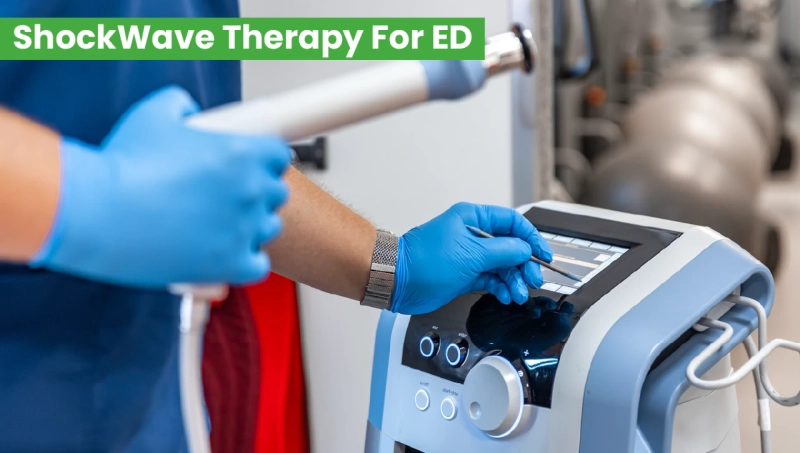Erectile Dysfunction (ED) is a condition that silently affects millions of men worldwide. According to the World Health Organization (WHO), nearly 1 in 5 men over the age of 40 experiences some degree of erectile difficulties, with numbers increasing sharply after age 60. In the United States alone, over 30 million men report ED symptoms, and the global prevalence is estimated at over 300 million men by 2025.
Traditionally, ED has been managed with medications like Viagra and Cialis, penile injections, or surgical implants. While effective, these treatments often provide only temporary relief or involve invasive procedures. Over the last decade, however, Shockwave Therapy (SWT) — a non-invasive technique that stimulates natural healing — has gained recognition as a potential long-term solution for ED.
This article takes a deep dive into shockwave therapy: how it works, the science behind it, clinical evidence, benefits, limitations, patient experiences, costs, and future developments.
What is Shockwave Therapy?
Shockwave therapy, also called Low-Intensity Extracorporeal Shockwave Therapy (Li-ESWT), is a medical technique that uses acoustic sound waves to stimulate biological changes in tissues.
Originally developed in the 1980s for breaking kidney stones (lithotripsy), shockwave therapy is now used in orthopedics, sports medicine, wound healing, cardiology, and urology. Its application in sexual medicine is relatively new but promising.
In ED treatment, the therapy targets penile tissue and blood vessels to restore normal blood circulation and improve erectile quality.
Types of Shockwave Therapy for ED
There are two main types of devices used in ED treatment:
- Focused Shockwave Therapy (fSWT):
- Penetrates deeper into penile tissue.
- More commonly used in clinical research.
- Targets the corpora cavernosa (erectile chambers).
- Radial Shockwave Therapy (rSWT):
- Spreads energy outward, less deep.
- More affordable but may be less effective for ED.
Clinics may use either or both, but focused therapy has stronger clinical evidence supporting its role in erectile function improvement.
The Science Behind Shockwave Therapy
Shockwave therapy works on the principle of mechanotransduction — the process by which mechanical energy (shockwaves) stimulates biological responses.
Biological Mechanisms
- Angiogenesis (New Blood Vessel Growth):
- Shockwaves cause microtrauma that triggers the release of vascular endothelial growth factor (VEGF), stimulating the growth of new blood vessels in the penis.
- Nitric Oxide Release:
- Shockwaves enhance the body’s production of nitric oxide (NO), a critical molecule for vasodilation and erection.
- Stem Cell Activation:
- Some studies suggest shockwaves may recruit stem cells to penile tissue, aiding in repair and regeneration.
- Nerve Regeneration:
- Early evidence indicates that SWT may help repair damaged penile nerves, particularly useful after pelvic surgery.
- Improved Smooth Muscle Function:
- The corpora cavernosa contain smooth muscles that relax to allow blood filling. Shockwave therapy improves their elasticity and responsiveness.
Who Can Benefit from Shockwave Therapy?
Shockwave therapy is not suitable for everyone. Ideal candidates typically include:
- Men with mild to moderate ED due to poor blood circulation.
- Patients with diabetes-related ED, where vascular damage is common.
- Men who do not respond to PDE5 inhibitors (Viagra, Cialis).
- Younger men with early-stage ED due to lifestyle or vascular health issues.
Not ideal for:
- Severe ED caused by nerve or hormonal deficiencies.
- Men with advanced Peyronie’s disease.
- Patients with penile implants.
The Patient Journey: What to Expect
Step 1: Initial Assessment
- Detailed medical history.
- Physical examination (including penile blood flow tests).
- Blood tests (testosterone, sugar levels, cholesterol).
Step 2: Treatment Sessions
- Conducted in an outpatient clinic.
- No anesthesia required.
- A probe delivers sound waves to the penis at specific points.
- Each session lasts 15–20 minutes.
Step 3: Recovery & Follow-Up
- No downtime — men can resume normal activities immediately.
- Some men notice changes after 3–4 sessions; others require full treatment.
- Follow-up assessments track progress.
Clinical Evidence and Research
Numerous studies have tested the effectiveness of shockwave therapy for ED:
- Vardi et al. (2010): First landmark study showed improvement in IIEF scores in men with vasculogenic ED.
- Meta-analysis (2019): Across 10 trials, over 70% of patients experienced improved erectile function.
- European Urology Guidelines (2022): Recognize Li-ESWT as a promising therapy but recommend it mainly for men with vasculogenic ED.
Results typically last 12–24 months, with maintenance therapy improving longevity.
Benefits of Shockwave Therapy
- Drug-free and surgery-free.
- Long-term effectiveness compared to pills.
- Minimal side effects — no systemic risks like headaches or blood pressure changes.
- Improves natural erections without dependence on medication.
- Quick and convenient — short, outpatient sessions.
Risks, Side Effects, and Controversies
Side Effects
- Mild redness or soreness at the site.
- Temporary tingling or swelling.
- Rare bruising.
Limitations & Controversies
- Not yet FDA-approved in the U.S. for ED.
- Effectiveness varies — around 20–30% of men may not respond.
- Long-term data is still limited.
- Some clinics may use unproven devices or protocols.
Cost of Shockwave Therapy
- Per session: $300 – $600
- Full package (6–12 sessions): $2,500 – $5,000
- Often not covered by insurance, as it is considered experimental in some regions.
Combination Therapies
Emerging research shows stronger results when shockwave therapy is combined with other regenerative techniques:
- Shockwave + Platelet-Rich Plasma (PRP): Boosts tissue healing.
- Shockwave + Stem Cell Therapy: Enhances regeneration.
- Shockwave + Lifestyle Modifications: Exercise, diet, and stress reduction amplify outcomes.
Shockwave Therapy vs Traditional ED Treatments
TreatmentProsConsOral MedicationsFast, easyTemporary, side effects, dependencyInjections (Trimix)Effective in resistant casesPainful, risk of fibrosisVacuum DevicesSafe, non-drugMechanical, awkwardSurgery (Implants)Permanent solutionInvasive, irreversibleShockwave TherapyLong-term, natural erectionsCostly, not universally effective
Frequently Asked Questions (FAQs)
1. Is shockwave therapy painful?
Most patients feel only a mild tapping sensation; no anesthesia is needed.
2. How soon can I see results?
Some men notice changes after 3 sessions, while others require the full treatment course.
3. Can I stop taking Viagra after treatment?
Many men reduce or stop medication use, but results vary.
4. Is it safe for diabetics and heart patients?
Yes — unlike ED pills, SWT does not affect blood pressure or interact with medications.
5. How long do results last?
Improvements can last 12–24 months, with some men requiring booster sessions.
6. Why isn’t it FDA-approved yet?
More large-scale clinical trials are needed for regulatory approval. However, it is approved and widely used in Europe, Asia, and the Middle East.
Future of Shockwave Therapy and ED Treatments
Shockwave therapy represents a shift from symptom management to disease modification in ED. As research progresses, we may see:
- Standardized protocols (currently varies by clinic).
- Combination regenerative therapies (PRP, stem cells).
- Insurance coverage as more evidence emerges.
- At-home devices (currently experimental).
Experts predict that shockwave therapy will become a mainstream ED treatment within the next decade, offering millions of men a safer and more natural path to sexual wellness.
Conclusion
Erectile dysfunction is more than a sexual issue — it impacts confidence, relationships, and overall quality of life. Shockwave therapy for ED offers a non-invasive, drug-free, and scientifically promising solution that addresses the root cause of erectile difficulties: poor blood circulation.
While not a miracle cure for everyone, it represents a revolutionary step forward in men’s sexual health. With continued research, improved protocols, and broader access, shockwave therapy has the potential to transform the treatment landscape for erectile dysfunction.
For men struggling with ED, consulting a qualified urologist about shockwave therapy could be the first step toward regaining not only sexual performance but also confidence and intimacy.



